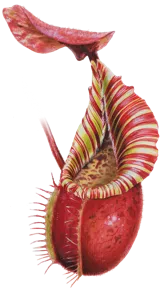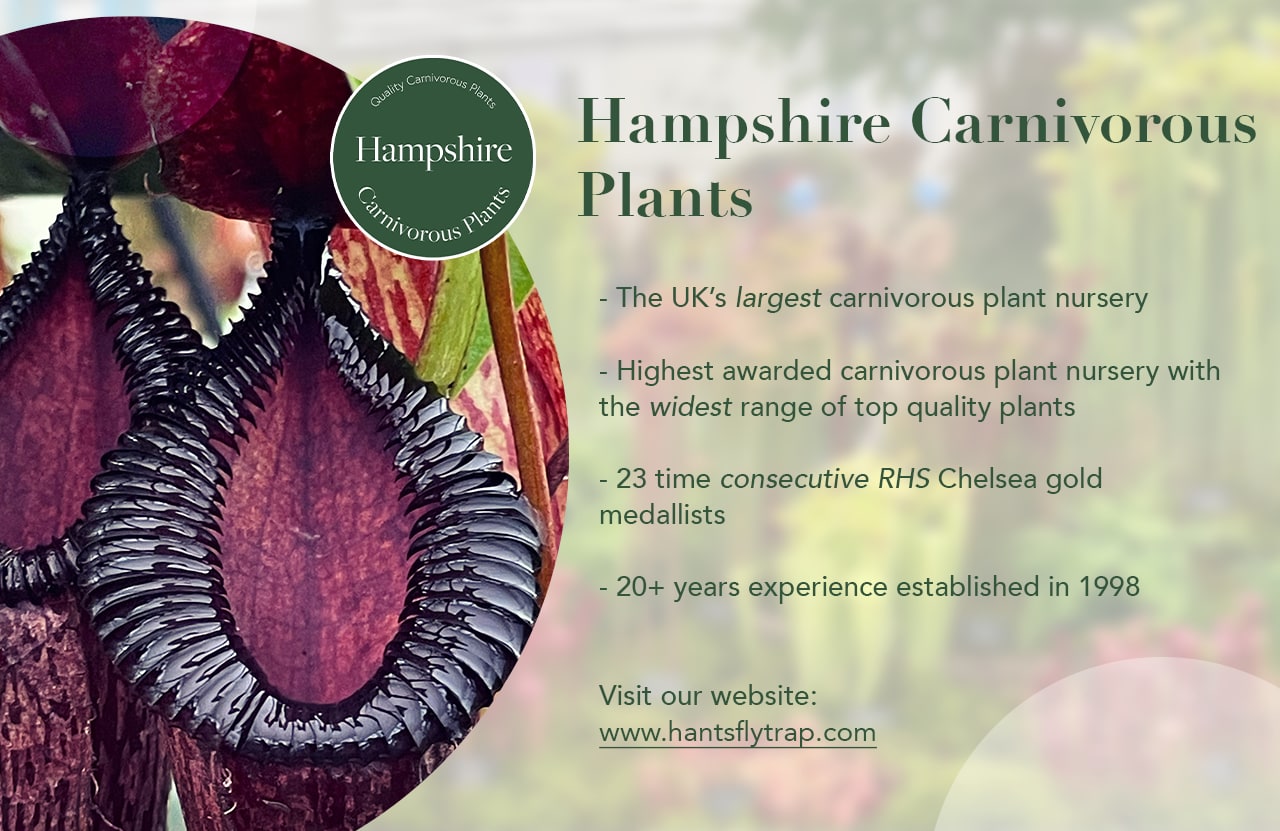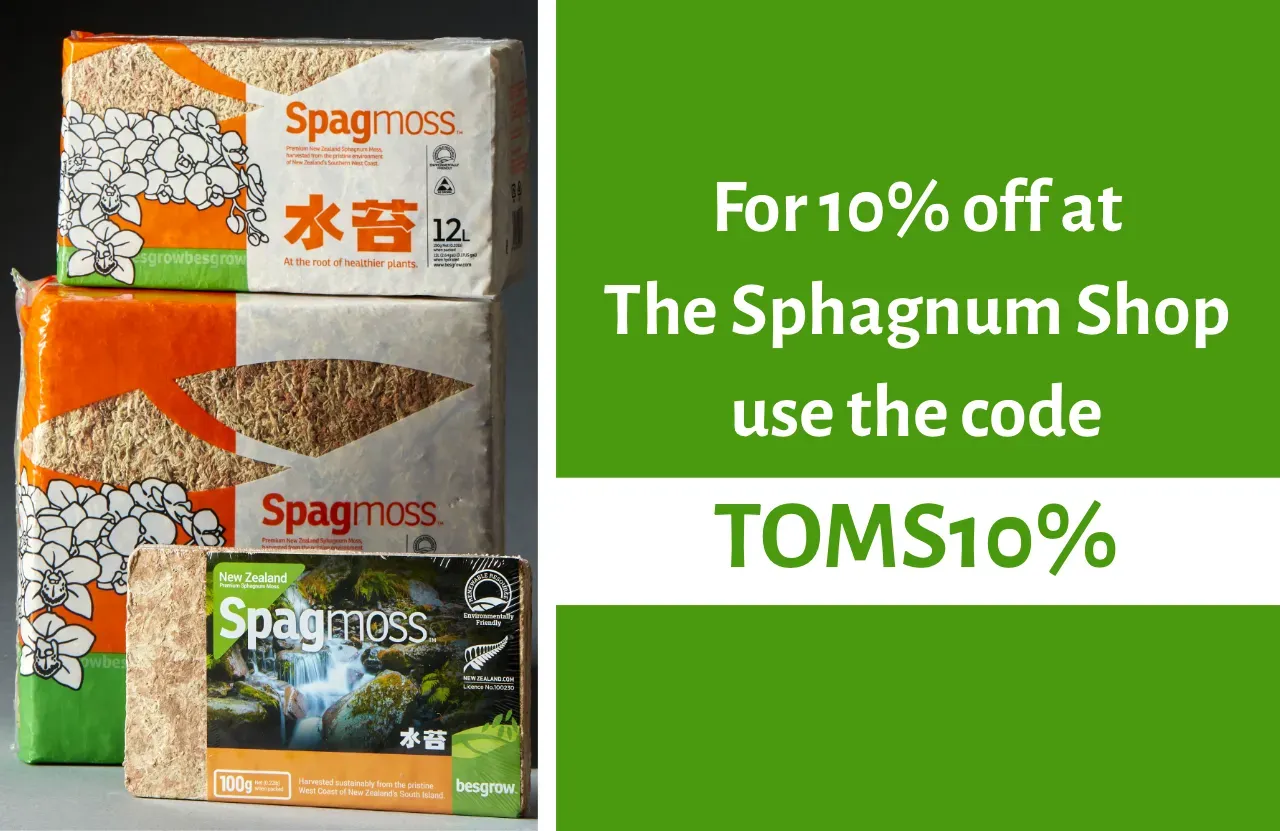As an Amazon Associate, I earn commission from qualifying purchases.
Nepenthes - also known as tropical pitcher plants or monkey cups - have been inspiring awe in botanists since they were first discovered by Europeans in the 17th century. With their dazzling colours and elaborately decorative traps, the plants seem to flaunt their carnivory with pride.
Ranging in size from diminutive miniatures like Nepenthes argentii to gargantuan monstrosities like Nepenthes rajah, the genus includes the only carnivorous plants known to have caught and eaten whole rats.
The genus is hugely diverse, and some species have stricter temperature requirements than others. Even so, most cultivation advice is broadly applicable to all Nepenthes. What’s more, many common hybrids are extremely tolerant growers and make excellent houseplants. Follow this guide and soon you’ll need to prune your Nepenthes to keep it in check!
Contents
- Growing Locations
- Species & Hybrids
- Soil for Nepenthes
- Watering Nepenthes
- Food for Nepenthes
- Flowers & Seeds
1. Growing Locations
There are over 170 species of Nepenthes, plus countless natural and cultivated hybrids. Their habitats are hugely diverse, and some are far more adaptable growers than others. For this reason, it’s difficult to offer generalised advice on growing locations which is applicable to all species! However, the guidance below is a good starting point and can be adapted to allow you to grow a wide variety of plants.
When selecting a location for your Nepenthes, there are four main things to consider:
- Light
- Temperature
- Humidity
- Space
We’ll go through each of these in turn, then look at some common growing locations and their associated advantages and disadvantages.
Light
Most tropical pitcher plants grow in the upper canopy of the rainforest and prefer very bright light, but without much direct sun. Diffused or partial sun is ideal. In the northern hemisphere that could be an east or west-facing window which receives direct sun for only part of the day, or a greenhouse with 50% shade cloth. Too much direct sun can burn their leaves.
Artificial light is also an option. High-powered fluorescent or LED lights (such as T5 growlights) work very well with Nepenthes. I’ve found that LEDs growlights can be particularly effective since they tend to give off less heat than fluorescent bulbs. Spindly leaves and a lack of colouration are signs of insufficient light, while blotchy red marks can be a sign your plant is getting more than enough light.
Click on any photo to zoom in. Use arrow keys or swipe to navigate.
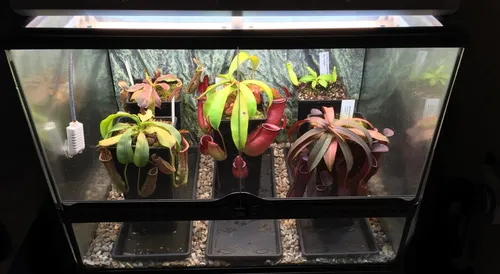 A Nepenthes terrarium with a T5 grow light, built by me many years ago.
A Nepenthes terrarium with a T5 grow light, built by me many years ago. 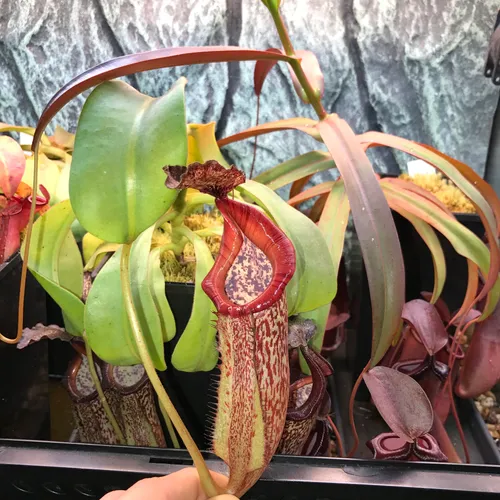 Nepenthes maxima thriving in my terrarium.
Nepenthes maxima thriving in my terrarium. Note that Nepenthes do not require a winter dormancy, but if you’re growing under natural light, the shorter daylight hours will often slow your plant down significantly.
Temperature
Each Nepenthes species grows best at the temperatures it experiences in its natural habitat. These temperatures correspond to the altitudes at which they grow in the wild. Remember that Nepenthes are tropical montane plants, and so most require some kind of temperature drop at night.
- For highlanders, this means warm days and cool nights, e.g. 20-25°C (68-77°F) during the day and 10-15°C (50-59°F) at night. These tend to be the showiest species.
- For lowlanders, you’ll need hot days and warm nights, e.g. closer to 30°C (86°F) days and 20°C (68°F) nights. Cold snaps can be lethal.
So-called intermediates sit somewhere in-between, while hybrids depend on the preference of the parent species. One very important thing to note is that hybrids are generally far more temperature-tolerant than pure species. This means that if you can’t provide sufficiently cool nights, your best bet is to try a hybrid or a tolerant intermediate. Many of these will grow quite happily on a cool windowsill.
Click on any photo to zoom in. Use arrow keys or swipe to navigate.
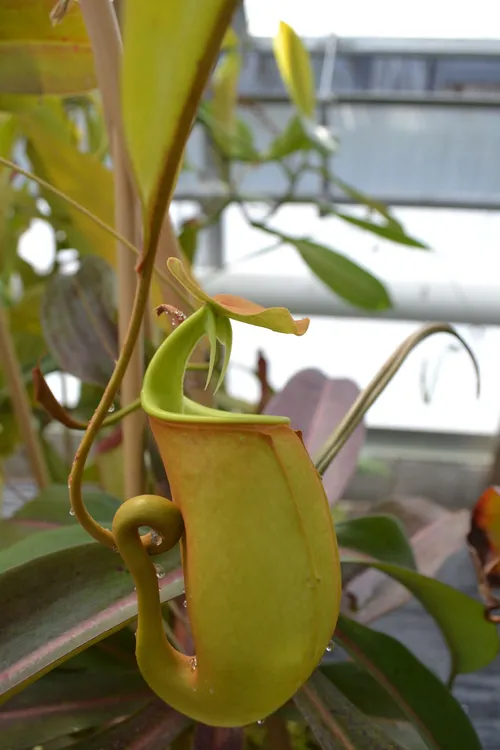 Nepenthes bicalarata at Chester Zoo, an example of a true lowlander.
Nepenthes bicalarata at Chester Zoo, an example of a true lowlander. .OnAKwRcK_ZL0l0R.webp) Nepenthes villosa, grown by Simon Lumb, an example of a true highlander.
Nepenthes villosa, grown by Simon Lumb, an example of a true highlander. I maintain a complete list of species - as well as a calculator to help estimate the temperature preferences of hybrids - on my Nepenthes Interactive Guide.
Humidity
Humidity should ideally be quite high - at least 50% relative humidity (RH) during the daytime, and higher at night. A lack of inflating pitchers on your plant can be a sign of insufficient humidity. Some growers have success using a misting bottle daily to raise humidity. I find it’s just as effective to water little and often, to keep the soil moist.
Many Nepenthes hybrids are particularly tolerant of lower humidity. I’ve found N. ‘Gaya’, N. ‘Bloody Mary’, and N. x ventrata to be particularly forgiving in this regard, along with hybrids involving hairy species like N. veitchii. All of these and more are available for sale from Hampshire Carnivorous Plants. If you’re in the US, you can buy all of these hybrids - and plenty more - from my recommended nursery California Carnivores. Don’t forget you can get a 10% discount on your order by using the code tomscarnivores.
In my experience, it’s also possible for humidity to be too high! Many growing guides suggest that 80-90% is optimal, but I’ve found that keeping the air so close to saturation can lead to issues with mould and fungus, particularly with low airflow. Nepenthes are quite adaptable to lower levels, as long as the growing media is kept moist. You can monitor your humidity using a SensorPush unit, available on Amazon.
Space
When you first start growing Nepenthes, space probably won’t be at the top of your list. Small plants often grow slowly and may take a while to adapt to the conditions of their new home. But if you are successful in cultivating these plants, space can quickly become a problem. Most Nepenthes are climbing or scrambling vines, and when they reach maturity some species can put out nearly a meter of stem per year!
Click on any photo to zoom in. Use arrow keys or swipe to navigate.
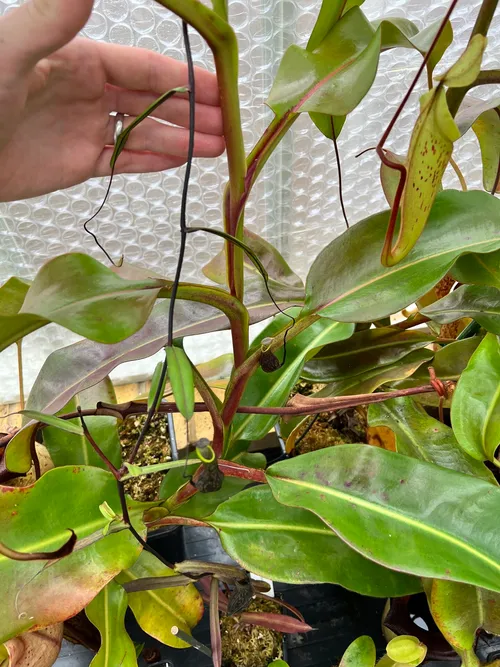 Nepenthes veitchii x burbidgeae starting to climb.
Nepenthes veitchii x burbidgeae starting to climb. 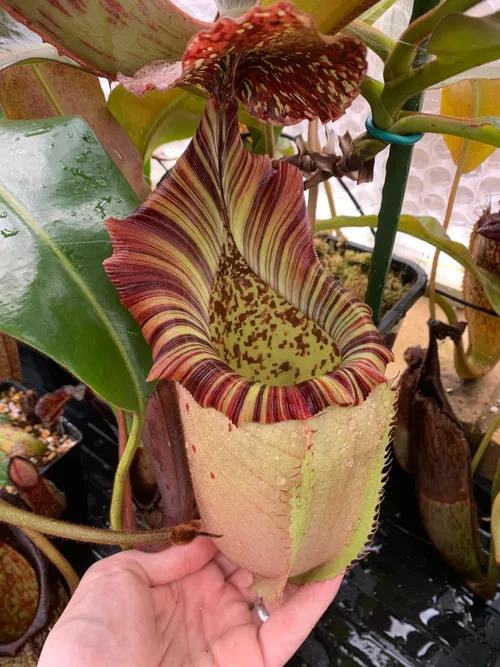 Pitcher on Nepenthes veitchii x burbidgeae holding over a pint of liquid.
Pitcher on Nepenthes veitchii x burbidgeae holding over a pint of liquid. This is worth bearing in mind if you opt for a terrarium or other enclosed space. You can try to source smaller species such as N. glabrata, or slower growers like N. veitchii. Either way, you may soon find yourself having to aggressively prune your plants!
Your Options!
- Windowsills: Some easy-to-grow species and cultivars (see below for suggestions) can adapt to the lower humidity of a bright windowsill, providing their other requirements are met. Regular light watering can help to raise humidity.
- Terrariums: Paired with T5 growlights, a large terrarium can be a great way to grow young plants. Remember that Nepenthes can get very large and will produce climbing vines - these will need to be pruned!
- Grow Tents: Providing you can maintain good humidity levels and avoid your lights overheating the interior of the tent, these can be a great way to grow a variety of species and hybrids. If you wish to grow highland and ultra-highland species but struggle to provide the necessary low temperatures, some enthusiasts have success cooling their tents at night with specially-adapted freezers.
- Greenhouses: A greenhouse heated to a minimum of 12°C and covered with shade cloth is undoubtedly the best way to grow a wide variety of highland Nepenthes species on a large scale - you can read about my own greenhouse setup here. Some growers create warm chambers within their greenhouses for lowlanders.
Click on any photo to zoom in. Use arrow keys or swipe to navigate.
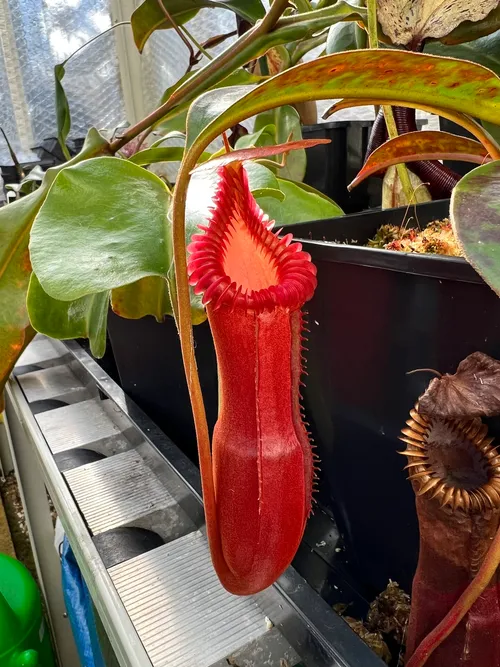 Nepenthes edwardsiana, another favourite.
Nepenthes edwardsiana, another favourite. 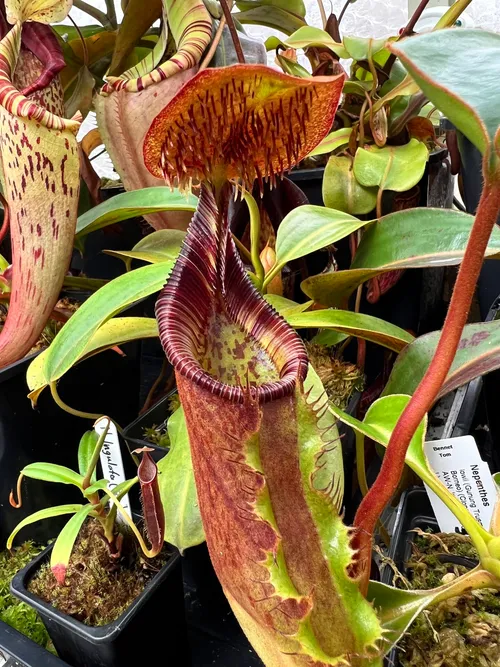 Nepenthes ephippiata, one of my favourite species, thriving in my greenhouse.
Nepenthes ephippiata, one of my favourite species, thriving in my greenhouse. 2. Species and hybrids
There are over 170 known species of Nepenthes, and more are described each year. What’s more, all of them are cross-fertile with one another to at least some degree. As a result there are many thousands of unique hybrids in cultivation, from simple primary hybrids to extraordinarily complex mixtures of dozens of species. Collecting and breeding tropical pitcher plants can easily become an addiction!
Note that Nepenthes hybrids are often easier growers than pure species plants (on account of so-called ‘hybrid vigour’). As such, don’t limit yourself to just species when looking to start your collection - in fact, starting with hybrids is often a good choice. If you wish to fully explore the diversity of this genus I’d recommend bookmarking both my Nepenthes Interactive Guide and this directory of my own Nepenthes collection.
For now, I’ll recommend some easy-to-grow hybrids and species:
Click on any photo to zoom in. Use arrow keys or swipe to navigate.
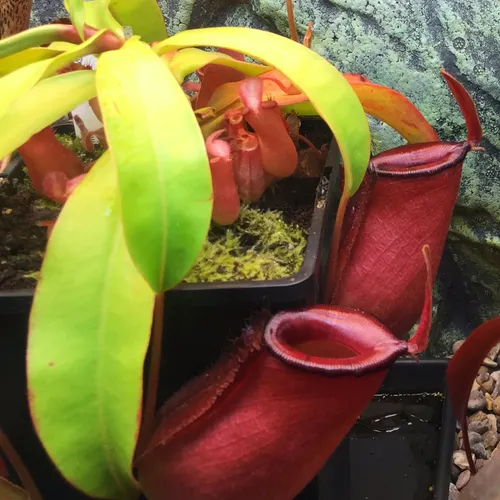 Nepenthes 'Bloody Mary'.
Nepenthes 'Bloody Mary'. 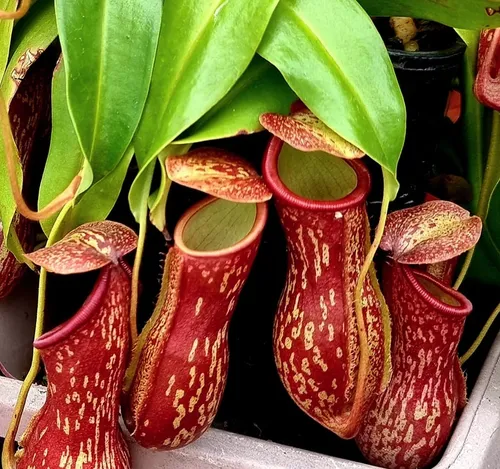 Nepenthes 'Gaya'.
Nepenthes 'Gaya'. 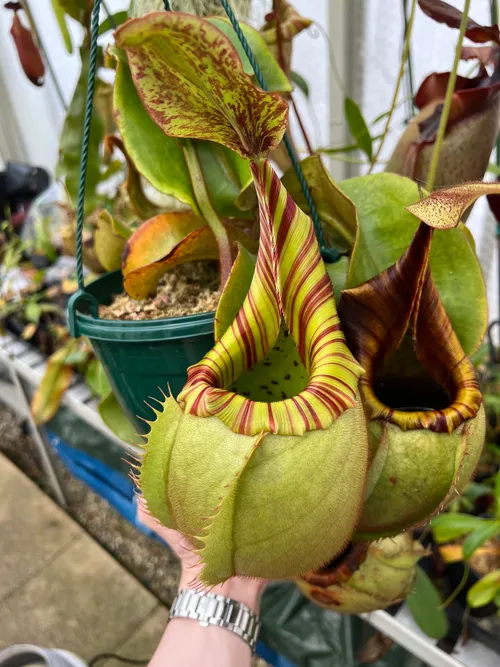 Nepenthes veitchii.
Nepenthes veitchii. 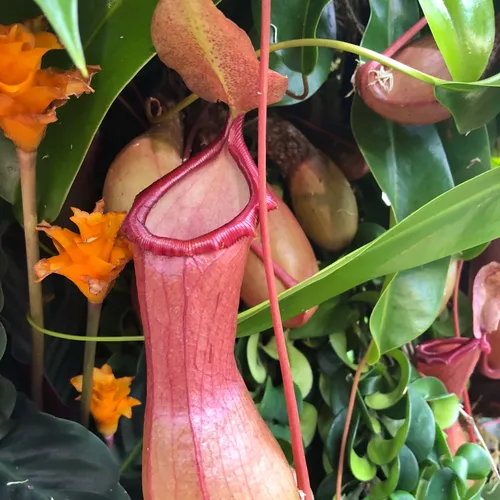 Nepenthes x ventrata.
Nepenthes x ventrata. - N. ventricosa x lowii: Also known as N. x briggsiana, this hybrid is a fast grower with red, woody pitchers and an attractively striped peristome. A great alternative to the more common N. x ventrata.
- N. ‘Bloody Mary’: A popular cultivar for terrariums, this is a beautiful hybrid between N. ventricosa and N. ampullaria. It has small, tubby, scarlet pitchers on glossy green leaves, and can grow into a very bushy plant!
- N. ‘Gaya’: A vigorous grower with red and yellow speckled pitchers, this cultivar is N. khasiana x (ventricosa x maxima). It’s a particularly good candidate for a houseplant.
- N. veitchii: A beautiful species and one of my favourites, N. veitchii has traps with wide peristomes and is covered in fuzzy brown hair. It’s particularly adaptable to lower humidity environments, a trait often passed to its hybrid offspring - so look out for hybrids with this species. Be sure to check out my profile of Nepenthes veitchii!
- N. maxima: Red patterning on a green background with a large, flamboyant red peristome (lip). Available in many varieties (including the famous wavy-leaf form), this is an attractive plant which is particularly adaptable to warmer conditions. I’ve written a detailed profile of Nepenthes maxima.
For UK growers, I highly recommend Hampshire Carnivorous Plants. They offer a nice selection of Nepenthes suitable for beginners, as well as rarer species suitable for experienced growers.
If you’re in the US, I highly recommend California Carnivores. They have a huge variety of Nepenthes in-stock for delivery throughout the United States, from tolerant hybrids suitable for beginners to exclusive releases of rare collectors’ items.
You can also get 10% off your order by using the code tomscarnivores at checkout.
3. Soil for Nepenthes
Nepenthes are very tolerant when it comes to soil. They enjoy a loose, low-nutrition growing medium which keeps their roots aerated and allows excess water to quickly drain away while still retaining some moisture.
Popular mixtures tend to include a combination of long-fibered sphagnum moss, orchid bark, tree fern fiber, coconut husk fiber, sand, perlite, and pumice rock in varying ratios. Many growers successfully grow their highlanders in pure long-fibered sphagnum moss. Exactly how coarse your soil should be is dependent on numerous other factors, including ambient humidity, frequency of watering, and the species and age of your plant.
Certain more challenging species - including some rare highland and ultra-highland Nepenthes - often benefit from a specific mixture which reflects their natural habitat (e.g. whether they grow terrestrially or as an ephiphyte). For example, I’ve found Nepenthes rajah and Nepenthes attenboroughii to benefit from a more ultramafic substrate - mine grow well in a mixture of peat moss, perlite, and kanuma. These two also prefer being given room for extensive root growth.
Click on any photo to zoom in. Use arrow keys or swipe to navigate.
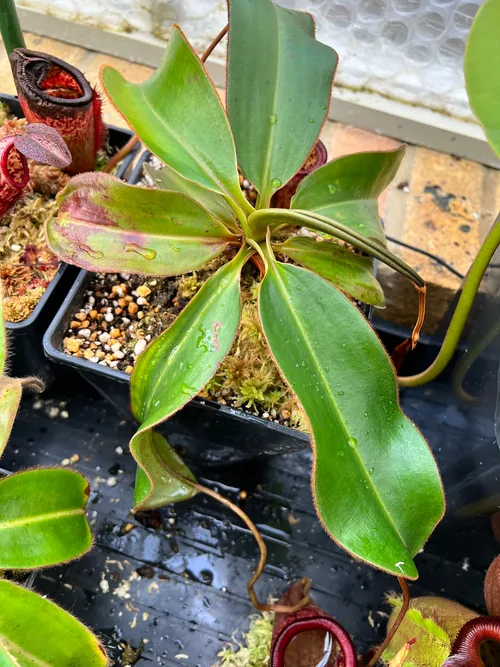 Nepenthes attenboroughii pitcher, growing in my ultramafic mix of peat, perlite, and kanuma.
Nepenthes attenboroughii pitcher, growing in my ultramafic mix of peat, perlite, and kanuma. 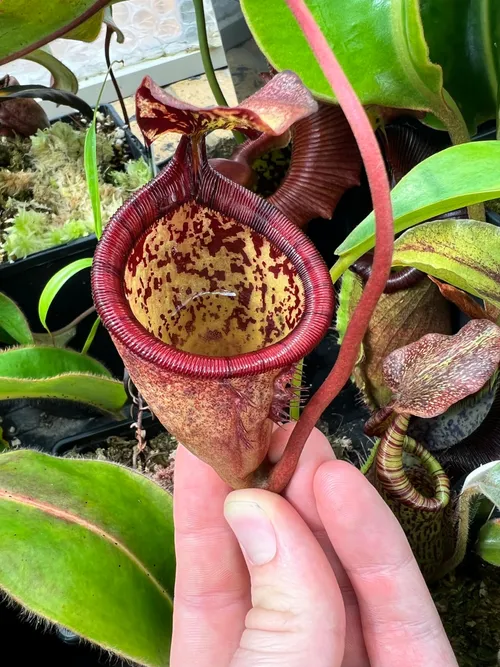 Nepenthes attenboroughii pitcher.
Nepenthes attenboroughii pitcher. As a general rule, however, a mixture of long-fibered sphagnum moss, perlite, and - optionally - orchid bark works well. In the UK, Hampshire Carnivorous Plants offers a good ready-made Nepenthes compost. In the US, California Carnivores offers an excellent ready-made soil mix for Nepenthes (look for their ‘premium mix’).
Alternatively, if you prefer to prepare your own, I highly recommend The Sphagnum Shop in the UK. You can get 10% off by using code TOMS10%.
4. Watering Nepenthes
Tropical pitcher plants benefit from frequent watering. Aim to keep the soil damp at all times and never let it dry out completely. Always use pots with plenty of drainage holes. Unlike many other carnivores, Nepenthes are not bog plants and do not appreciate having waterlogged soil. As such, avoid standing them in water for extended periods, since this can cause root rot. Some growers stand their pots on a layer of plastic egg crate, which helps excess water drain away.
Nepenthes are more tolerant of water impurities and dissolved minerals than other carnivorous plants. Whereas North American pitcher plants (Sarracenia) will quickly deteriorate if given hard water from the tap, tropical pitcher plants do not seem to mind as much. I’ve even seen mineral deposits build up on leaves, and the plants didn’t seem to mind. That said, impurities can build up over time and will often accelerate the breakdown of your soil mixture.
For long-term healthy growth, stick to rainwater, distilled or deionised water, or water purified using a reverse-osmosis (RO) system. I’ve written more about water for carnivorous plants, so be sure to give that a read if you’re unsure what to do.
5. Food for Nepenthes
If you are growing your Nepenthes where they will not be able to catch their own food, dried insects can be dropped into the pitchers every few weeks. These should be small enough to fit comfortably inside the pitcher. Do not overfeed, or your plant’s pitchers may turn black and rot.
My recommended foods for Venus flytraps will all work, but dried crickets are particularly suitable for Nepenthes. For experienced growers with larger collections, you could also try Osmocote Flower and Vegetable pellets - I tried these following a recommendation from Peter D’Amato, and my plants seemed to enjoy them. In my experience, though, the most effective food for Nepenthes is a water-soluble seaweed-based fertiliser, mixed in a spray bottle and squirted into the pitchers every few weeks.
The results have been excellent, as you can see below!
Click on any photo to zoom in. Use arrow keys or swipe to navigate.
..Bx-QkVoT_ZVe3ke.webp) Nepenthes rajah x (burbidgeae x edwardsiana).
Nepenthes rajah x (burbidgeae x edwardsiana). 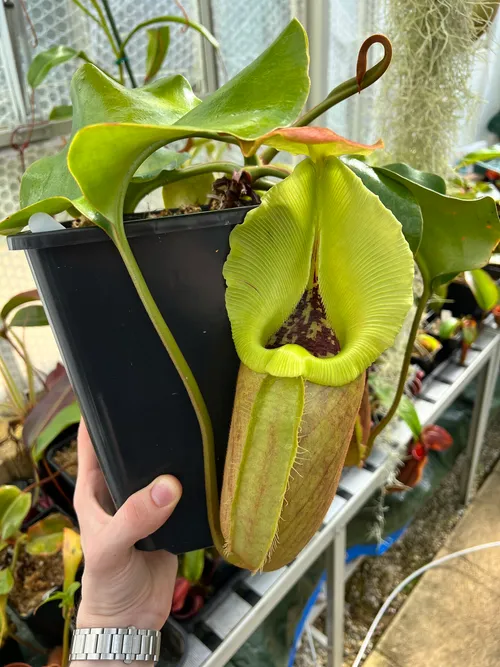 Nepenthes robcantleyi.
Nepenthes robcantleyi. 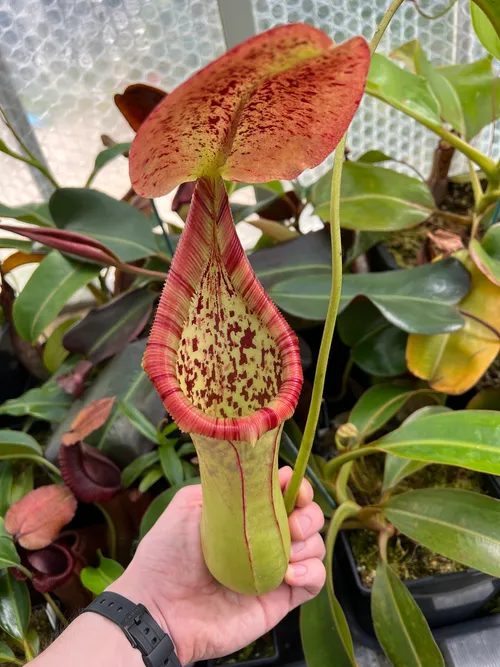 Nepenthes truncata x ephippiata, known to catch mice!
Nepenthes truncata x ephippiata, known to catch mice! 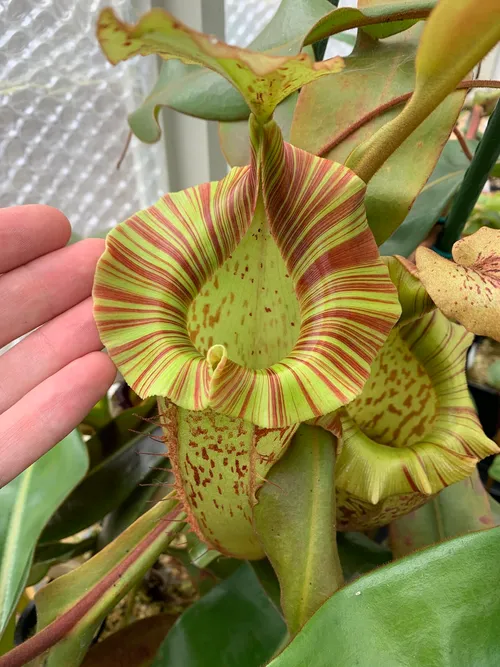 Nepenthes veitchii x platychila.
Nepenthes veitchii x platychila. Unlike many other carnivores, Nepenthes can also benefit from foliar fertilisation. During the spring & summer, spraying your plant with a weak solution of high-quality orchid fertiliser several times a month can help promote good growth. I use a foliar spray that doubles as a natural pesticide, and apply it every 2 weeks in the growing season - it’s available on Amazon.
As with all carnivorous plants, remember that food and fertiliser should be near the end of your priority list! No fertiliser is better than too much. You should aim to take care of all your plant’s other needs (lighting, temperature, humidity, and so on) before thinking about feeding & fertilisation.
6. Flowers & Seeds
Tropical pitcher plants are native to equatorial regions that have fairly stable conditions year-round. When grown in the northern hemisphere, Nepenthes don’t always flower on a regular schedule like plants native to temperate climates. It varies by species, but in my experience many mature Nepenthes grown under natural light will flower in the Autumn.
You’ll know when a Nepenthes is about to flower when it produces an infloresence before its next leaf. These look very different from normal leaves and pitchers - a bit like a miniature corn cob.
Click on any photo to zoom in. Use arrow keys or swipe to navigate.
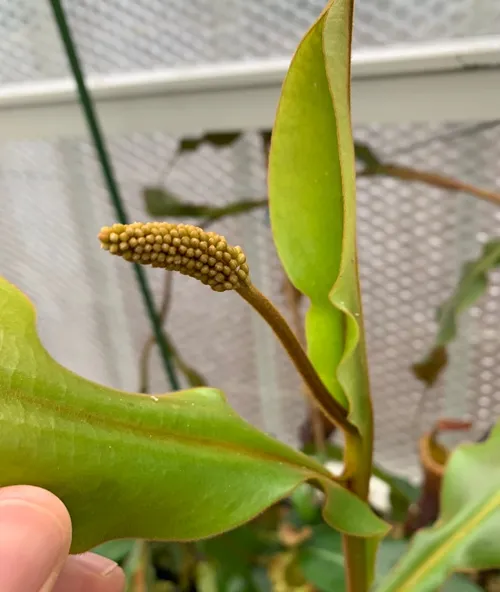 A female Nepenthes inflorescence.
A female Nepenthes inflorescence. 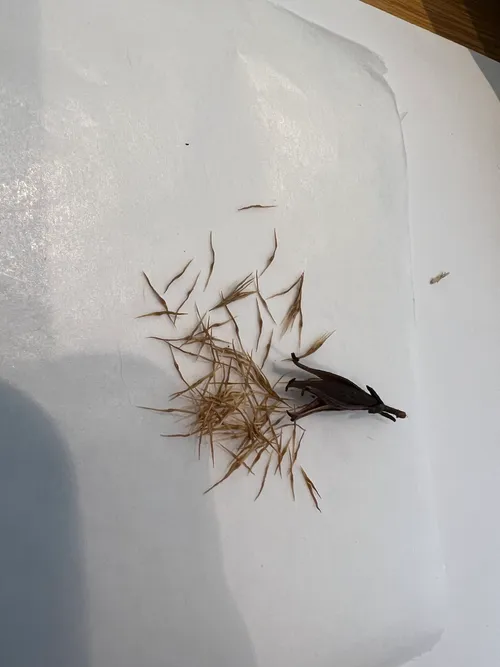 A fully ripe Nepenthes seed pod split open and ready to harvest.
A fully ripe Nepenthes seed pod split open and ready to harvest. 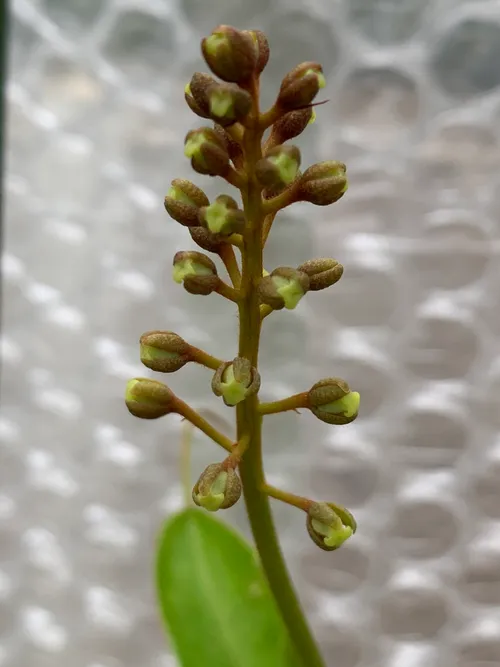 Female Nepenthes flowers opening.
Female Nepenthes flowers opening. 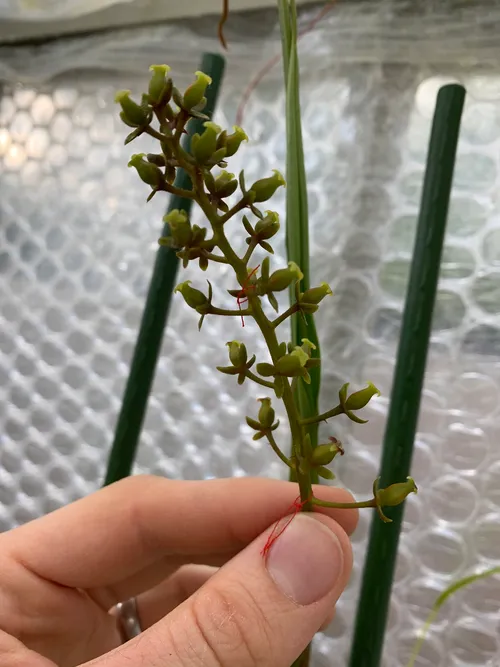 Female Nepenthes flowers swelling, some time after being pollinated.
Female Nepenthes flowers swelling, some time after being pollinated. 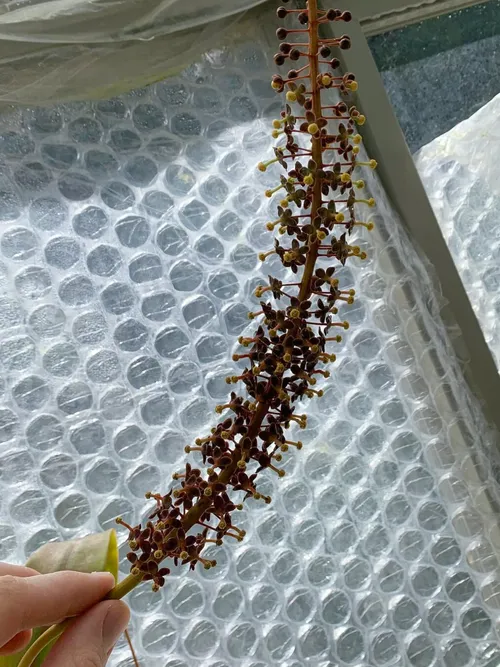 Flowers on a male Nepenthes producing yellow pollen.
Flowers on a male Nepenthes producing yellow pollen. 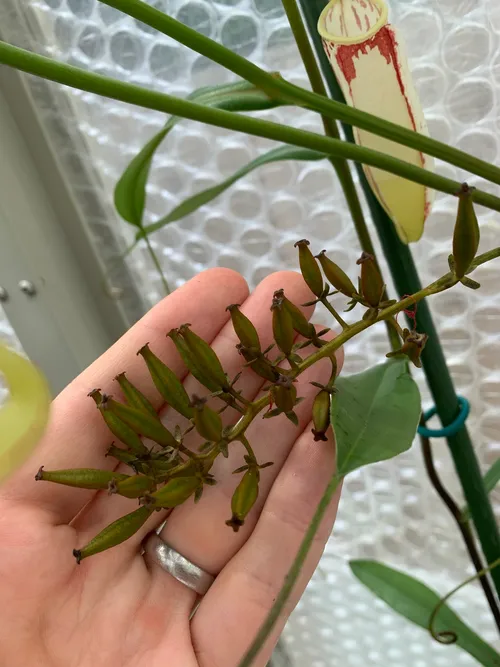 Seed pods ripening on a female Nepenthes.
Seed pods ripening on a female Nepenthes. One of the many fascinating things about Nepenthes is that they are dioecious, meaning all individual plants are either male or female! This is extremely unusual among plants, which normally have both male and female reproductive parts in their flowers (pollen from anthers, and a female stigma). As a result, Nepenthes cannot self-pollinate, so you’ll need a male and a female in flower at the same time in order to produce seed. This is one reason why species seed is seldom produced in cultivation - even if you are a skilled enough grower to have multiple mature specimens of the same species in flower at the same time, there’s no guarantee you’ll have a male and a female.
Growing Nepenthes from seed
First, prepare your media. I typically germinate seed on my usual mixture of long-fibered sphagnum moss and perlite, but with two differences:
- On top of the media I add a thin layer of finely chopped sphagnum, which I press down slightly. This provides a nice flat surface, ensuring seeds have good contact with the media and don’t get lost under big coarse pieces of sphagnum.
- I microwave the media (and let it cool!) before sowing the seeds, killing any pathogens and spores.
Sow the seeds on your media and mist with pure water. Don’t bury them or put any media on top of them. Cover the pot with clingfilm or a dome to ensure very high humidity, and place in a warm bright spot out of direct sunlight. If you have a greenhouse, under the benches is perfect.
Some growers find that highlanders will germinate best in warmer temperatures than they would prefer as adult plants. This may well be true, but I grow all my Nepenthes - including seedlings - in largely the same conditions. When fresh, Nepenthes seed will typically germinate in about 6-8 weeks. Viability decreases rapidly in the weeks after the seed is harvested. Once you’ve spotted germination, keep the humidity very high and put the pot under strong artificial light if possible.
Click on any photo to zoom in. Use arrow keys or swipe to navigate.
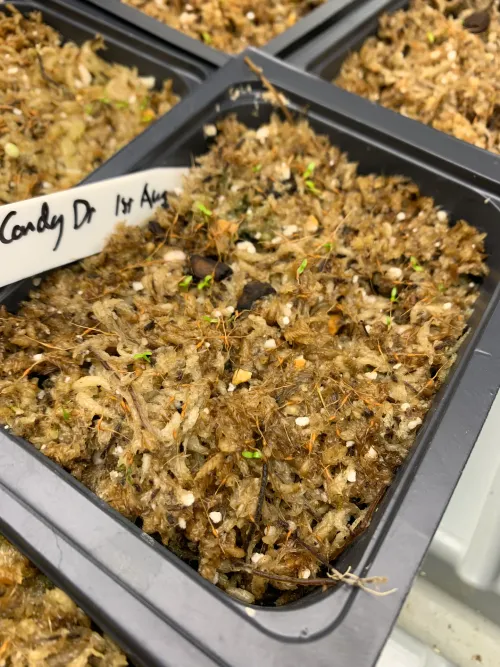 Freshly germinated Nepenthes seedlings, with tiny cotyledons.
Freshly germinated Nepenthes seedlings, with tiny cotyledons. 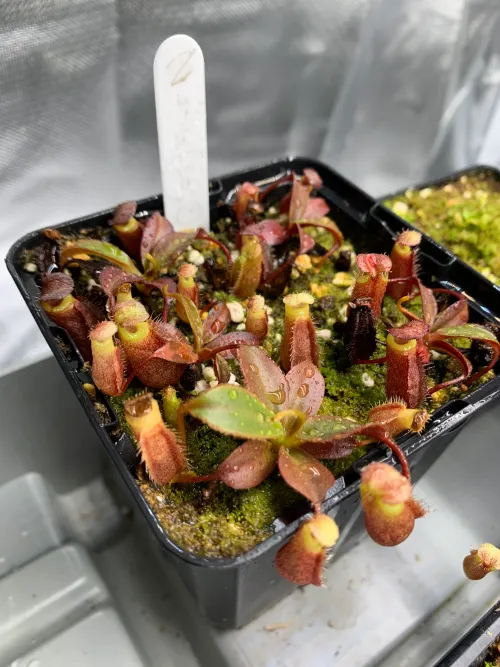 N. attenboroughii seedlings, about 2 years old and due another repot.
N. attenboroughii seedlings, about 2 years old and due another repot. 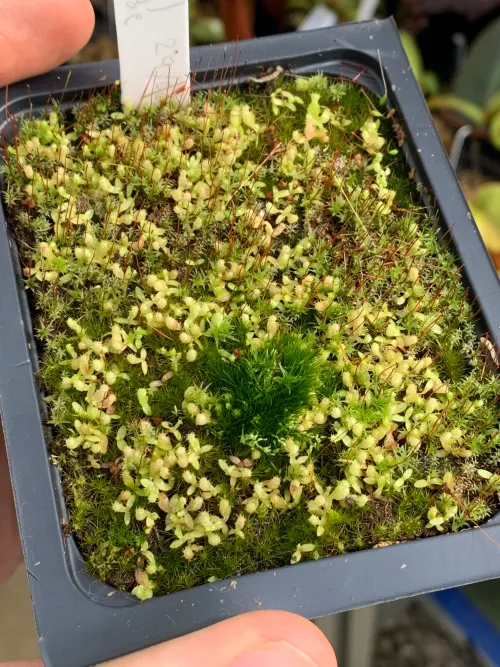 Some neglected seedlings, overgrown with moss and overdue a repot!
Some neglected seedlings, overgrown with moss and overdue a repot! 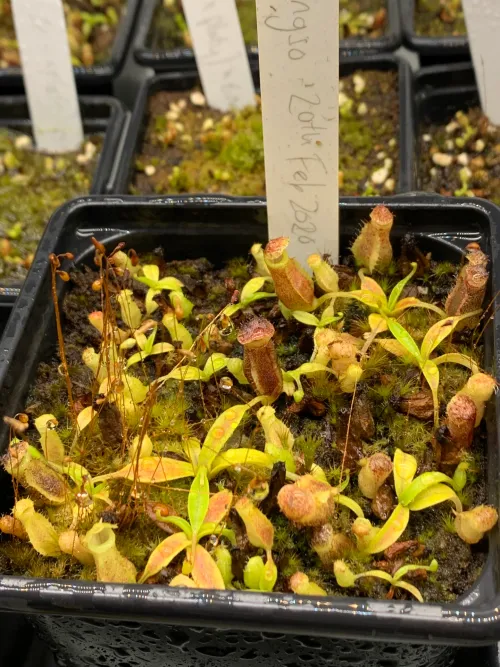 These are about 18 months old and in their second pot - probably due another repot soon.
These are about 18 months old and in their second pot - probably due another repot soon. I actually find the biggest challenge growing Nepenthes from seed is keeping them alive for the first 2 years after germination. In each batch of seed, a small percentage of the offspring seem to unavoidably wither and die while tiny. Others will linger on without putting on significant size, sometimes for years. Don’t give up hope! Keep the plants under good light, fertilise them with Maxsea or similar, and - after a year or so - separate out the good growers into fresh media.
Still want to learn more?
- The Savage Garden, by Peter D’Amato. In my opinion, this is the best introduction to carnivorous plants you can buy. Its chapters on Nepenthes are detailed and accessible and include some brilliant photography. Available on Amazon.
- Discover all 170+ species. I maintain a complete list of Nepenthes species, and have also built a calculator to help estimate the requirements of hybrids. Take a look at my Nepenthes Interactive Guide.
- Identify your Nepenthes. If you’re not sure what species you’ve got, you could try putting it into the Nepenthes Species Identifier. This is an AI-powered image recognition app which can identify many popular pitcher plant species.
Top photo: Nepenthes madagascariensis, by Tom Ballinger.
Happy growing!
